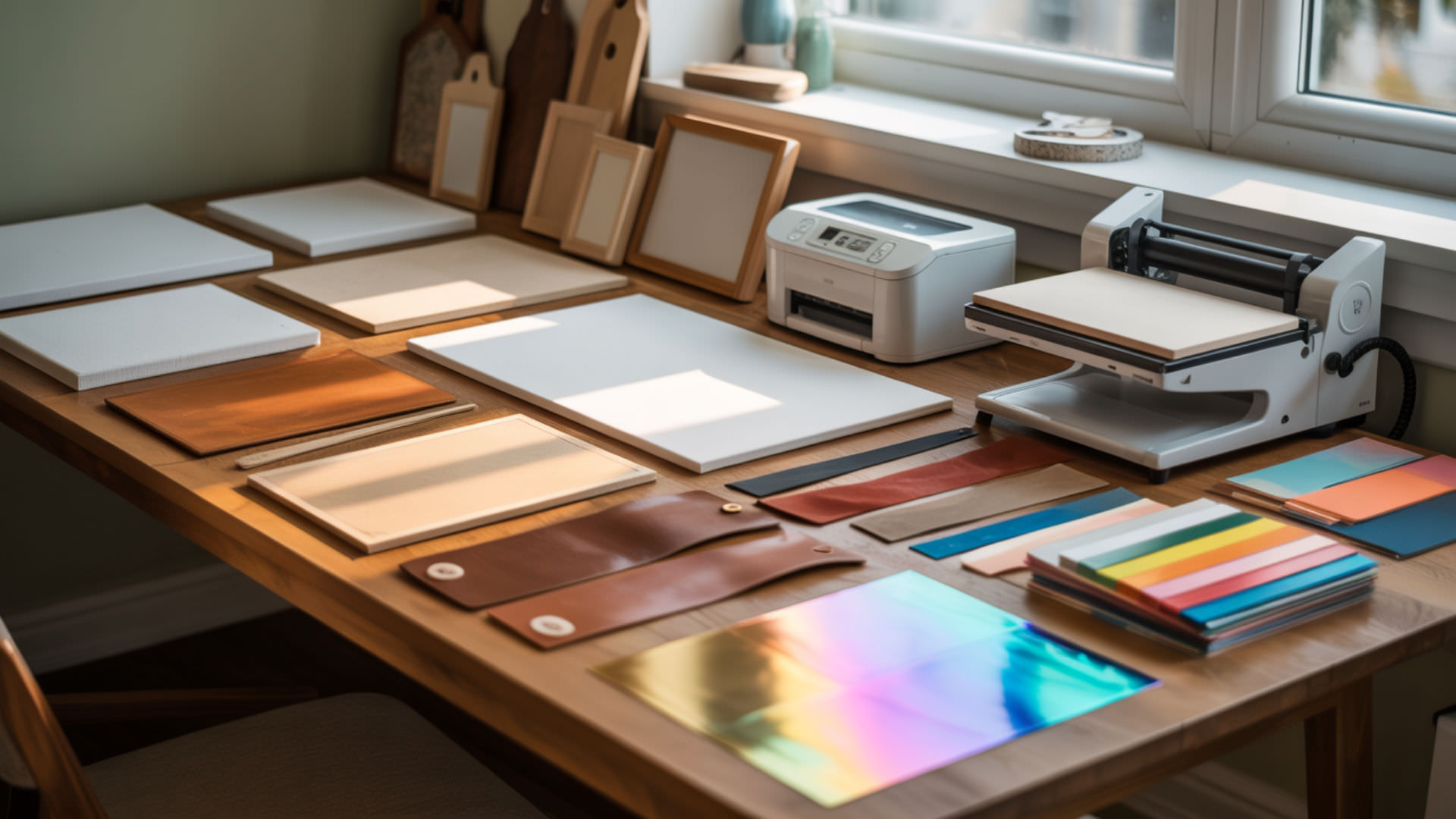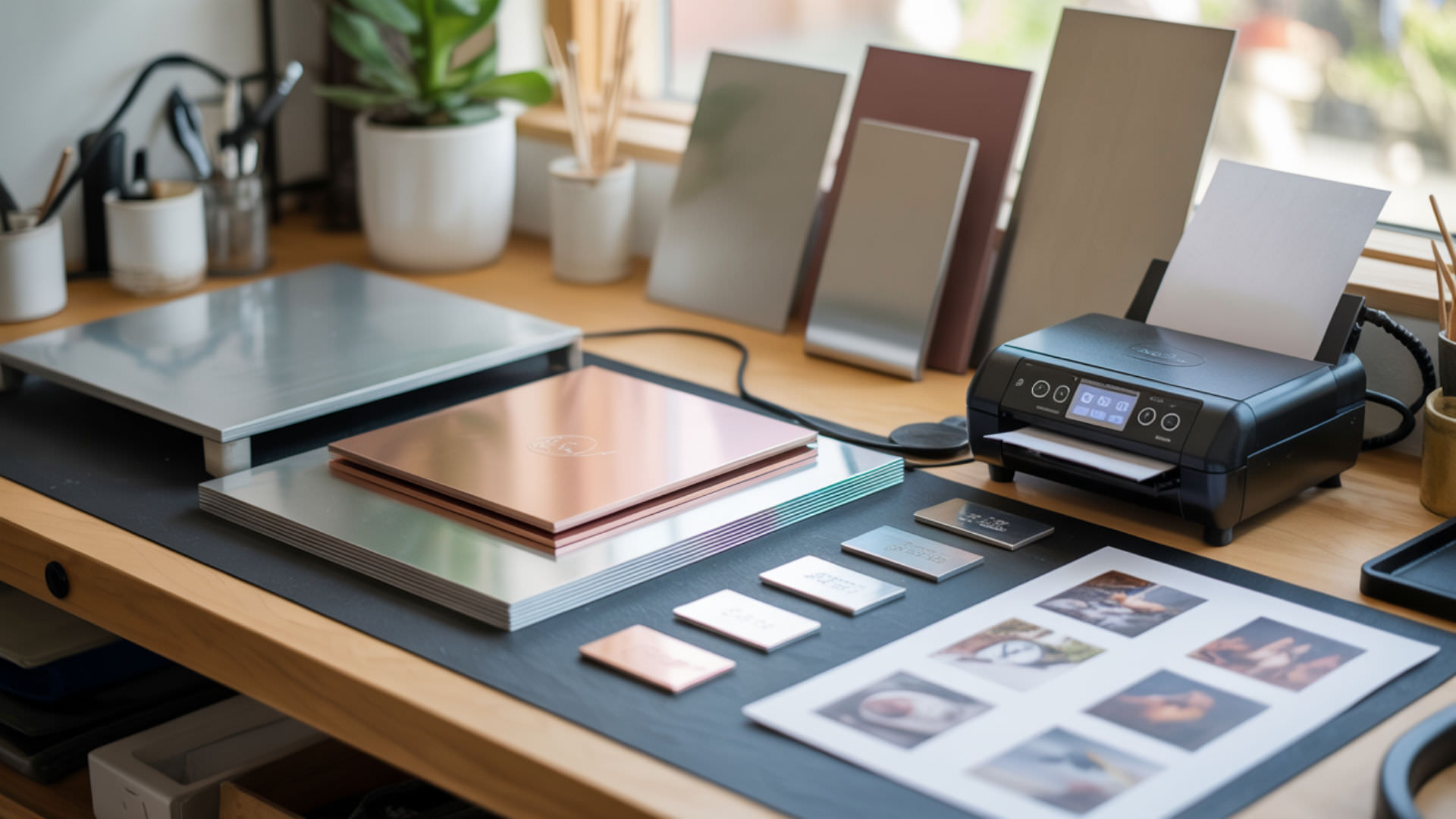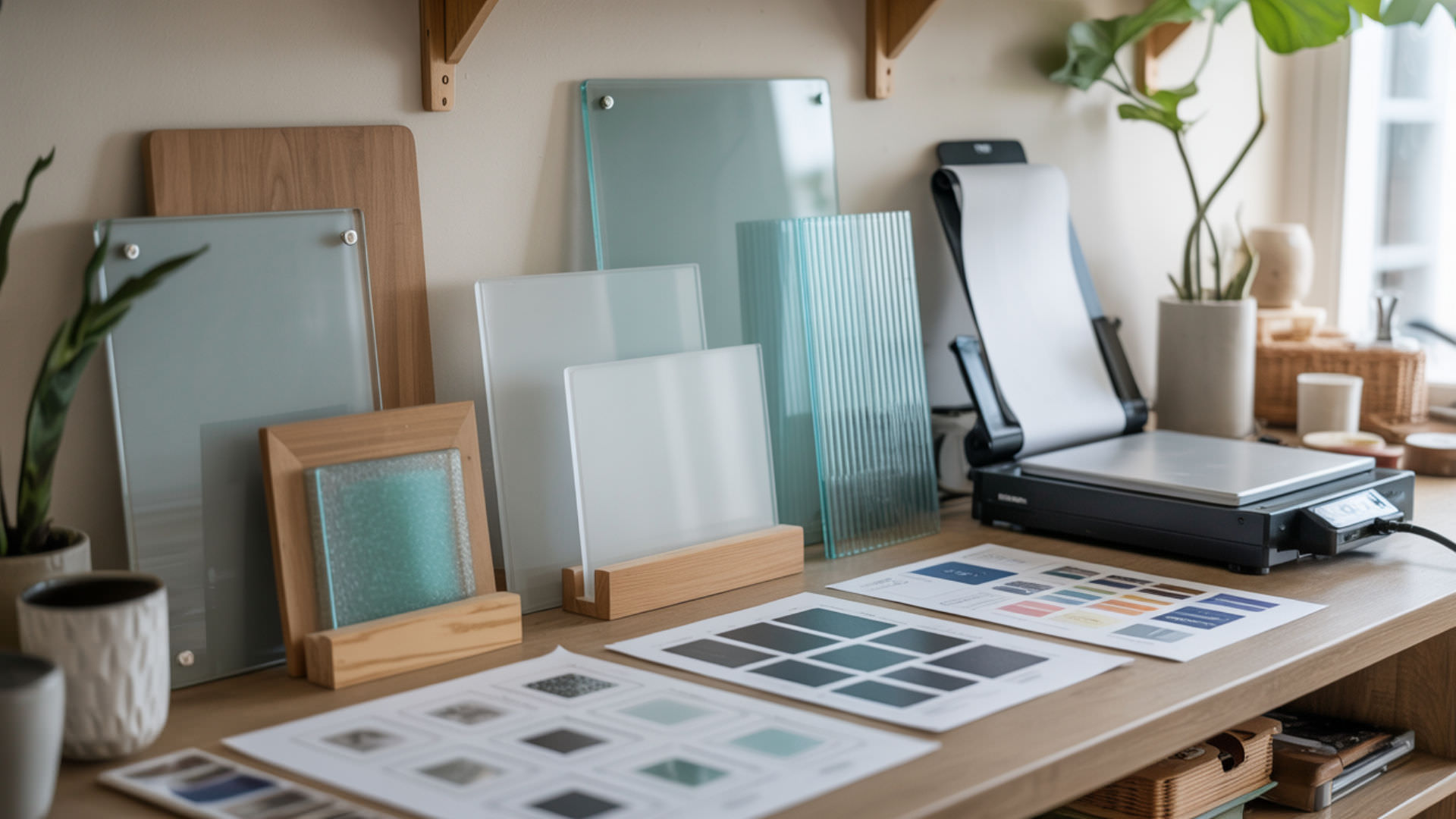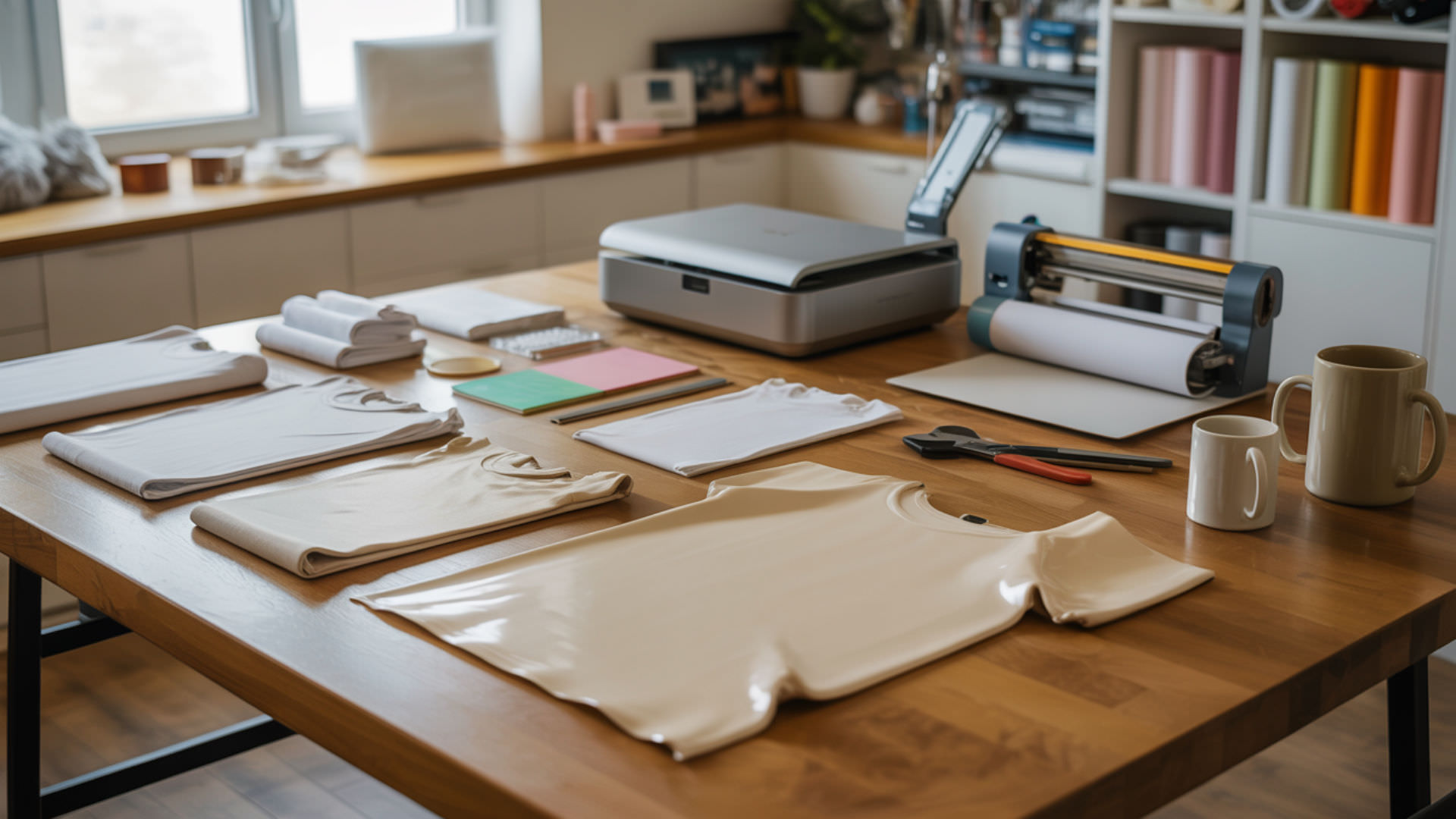Table of Contents
ToggleSlate sublimation produces rustic, natural-looking photo plaques and coasters with unique chiseled edges that make each piece one-of-a-kind. The porous natural stone surface cannot bond sublimation dye without a polymer coating—raw slate lacks the molecular structure for permanent ink adhesion. The polymer-dye bonding principle that governs slate compatibility is explained in our guide to sublimation on materials.
Key Takeaways
- Slate requires polyester coating for sublimation—the porous stone surface needs sealed, coated treatment for even dye absorption.
- Press at 385–400°F for 6–9 minutes with firm pressure—longer times than metal due to slate’s thickness.
- Preheat slate for 30 seconds before pressing to prevent thermal shock cracking from sudden temperature changes.
Can sublimation ink transfer onto slate surfaces?

Raw slate has low effective dye receptivity despite high surface energy—the porous stone cannot bond sublimation ink without polymer treatment. Polyester coating provides the receptive polymer layer that captures gaseous dye during heat transfer at 400°F. Pre-coated sublimation slate blanks feature white coating on one side specifically designed for vibrant, permanent image transfer.
Can slate be sublimated with transfer paper and heat?
Transfer paper carries sublimation ink to the coated slate surface where heat press activation at 385–400°F converts solid dye to gas. Press temperature must reach activation threshold for complete dye penetration into the polymer coating. Secure paper with heat-resistant tape to prevent shifting that causes ghosting during the 6–9 minute pressing cycle.
What happens if slate overheats during sublimation pressing?
Overheating causes uneven thermal expansion that leads to cracking in brittle slate—the natural stone structure fractures under internal stress from temperature differentials. Slate can withstand temperatures up to 800°C without melting but suffers breakage from rapid temperature changes. Stay within 385–400°F and avoid sudden cooling to prevent stress fractures. Slate is a fine-grained metamorphic stone that can develop internal stress and cracking when subjected to uneven heating due to its layered mineral structure. [1]
What preparation does slate need before sublimation?

Pre-press slate for 30 seconds at 400°F to drive out moisture trapped in the porous stone that causes steam marks and blotching during transfer. Porosity of natural slate absorbs humidity from the air, creating potential for uneven sublimation results without proper pre-heating. Both slate and wood are porous materials requiring pre-pressing and sealing, as detailed in our guide to porosity considerations for wood sublimation. Porous stone materials contain interconnected void spaces that can hold moisture, which explains why slate must be preheated before sublimation to prevent steam-related defects. [2]
How do you prepare the surface of slate for sublimation transfers?
Clean the coated surface thoroughly with a lint roller multiple times to remove dust and debris that cause defects. Position transfer paper face-down on the white coated side and secure with heat-resistant tape around all edges to prevent shifting that causes ghosting. Protective sheet (butcher paper) above and below protects the press from ink blowout.
What time and temperature influence slate sublimation results?
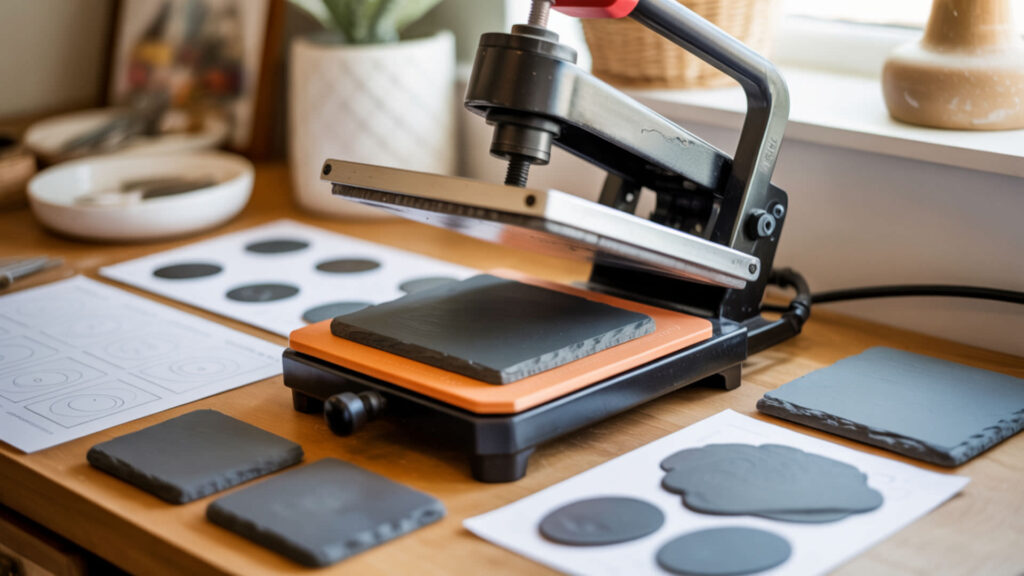
Press temperature of 385–400°F for 6–9 minutes produces optimal results on coated slate blanks—the thick, high-mass material requires extended time compared to thin metal or fabric substrates. Heat capacity of natural stone means longer press cycles for even dye activation throughout the coating layer. Coated blanks including slate photo panel products are evaluated by coating quality in our guide to best sublimation blanks for different materials.
How long should slate be pressed during sublimation?
Slate requires 360–540 seconds (6–9 minutes) depending on thickness—small coasters need 6–7 minutes while large rectangular plaques need 8–9 minutes at 400°F. Low thermal conductivity means the coating takes longer to reach activation temperature compared to aluminum or glass. Press face-down for better edge coverage on beveled slate surfaces.
Does sublimation occur at a fixed temperature over slate?
Press temperature should remain consistent at 385–400°F throughout the transfer cycle—fluctuations cause uneven dye activation and color inconsistency. Too low temperature produces underdeveloped, dull colors, while too high increases cracking risk from excessive thermal expansion. Use a heat conductive green pad to distribute temperature evenly across uneven slate surfaces.
How do you sublimate on slate step-by-step?

Proper pressing technique ensures clean transfer on slate while protecting equipment from ink blowout and the brittle stone from thermal shock.
- Clean coated surface with lint roller multiple times to remove all dust and debris that cause transfer defects.
- Print mirrored design on sublimation paper with bleed extending beyond slate edges for full coverage.
- Preheat blank slate for 30 seconds at 400°F to remove moisture and prevent thermal shock cracking.
- Place transfer paper face-up, position slate face-down on design, and secure edges with heat-resistant tape.
- Add protective sheet below and on top, then press at 385–400°F for 6–9 minutes with firm pressure.
- Allow 10+ seconds cooling before removing slate with heat-resistant gloves—peel transfer paper to reveal design.
Can slate withstand sublimation transfer heat safely?
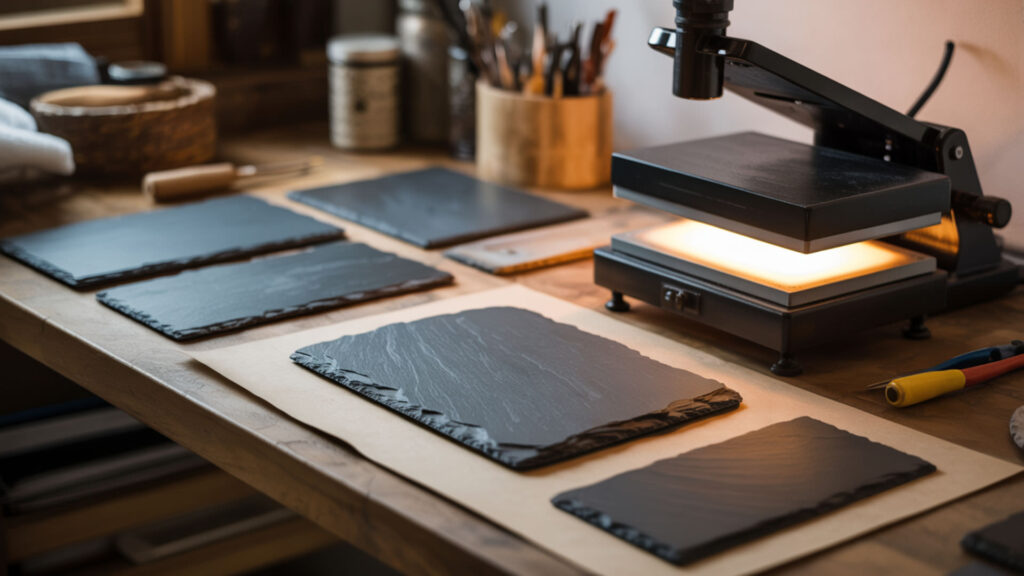
Natural slate is highly heat-resistant with Class A fire rating, withstanding temperatures up to 800°C without melting. Brittleness creates vulnerability to cracking from rapid temperature changes rather than heat damage itself. Slow, controlled cooling rate reduces internal stress that leads to fractures. Both slate and glass share similar thermal-shock and cracking risks due to brittleness under high heat, as covered in our glass sublimation guide.
Will slate crack if exposed to high pressing heat?
Excessive heat or rapid temperature changes create internal stresses that fracture slate—the natural stone structure cannot flex under uneven thermal expansion. Preheating for 30 seconds before pressing and allowing gradual cooling afterward prevents the sudden temperature differentials that cause cracking. Avoid temperatures above 400°F and never place hot slate on cold surfaces.
Ready to start sublimating on slate?
Quality polyester coating is the key to stable, vibrant images on slate—without proper polymer treatment, dye cannot bond permanently to the porous stone surface. Pre-coated slate blanks from reputable suppliers provide consistent results at 385–400°F for 6–9 minutes with firm pressure. Preheat to prevent cracking and allow gradual cooling to master this rustic substrate.
Frequently Asked Questions
Can designs be printed on slate using sublimation transfers?
Designs transfer successfully onto slate with proper polyester-coated blanks at 385–400°F for 6–9 minutes with firm pressure. Raw uncoated slate cannot accept sublimation ink—only specially treated blanks with polymer coating bond dye permanently. Print designs mirrored on sublimation paper and position face-down on the white coated surface for transfer.
Is slate heat resistant enough for sublimation pressing?
Natural slate withstands temperatures up to 800°C without burning or melting—sublimation temperatures of 385–400°F pose no heat damage risk. The concern is thermal shock from rapid temperature changes causing cracking rather than heat damage itself. Preheat blanks for 30 seconds and allow gradual cooling to prevent stress fractures.
Can hot objects be placed on slate without surface damage?
Sublimated slate can serve as trivets for hot dishes since natural stone handles high temperatures safely. However, do not expose sublimated slate to temperatures above 385°F after printing—excess heat can reactivate sublimation ink causing fading or color shifts. The polyester coating, not the stone, limits post-sublimation temperature tolerance.
Does slate transfer heat quickly or slowly when pressed?
Slate has low thermal conductivity, meaning it heats slowly and retains warmth longer than metal or glass substrates. This property requires extended press times of 6–9 minutes to bring the coating to full activation temperature. Use a heat conductive green pad to distribute heat evenly across uneven slate surfaces for consistent results.
Can sublimated slate be reheated later to deepen faded colors?
Re-pressing faded slate with fresh transfer paper is risky due to potential thermal shock from repeated heating cycles on already-stressed material. Press temperature inconsistencies or coating degradation may cause uneven results on re-pressed items. Test on damaged or scrap pieces first—original pressing determines maximum color vibrancy achievable.
References
- (n.d.). U.S. Geological Survey Publications Warehouse. https://pubs.usgs.gov/bul/0586/report.pdf
- Permeability-porosity data sets for sandstones. (2004, January 1). USGS. https://www.usgs.gov/publications/permeability-porosity-data-sets-sandstones




